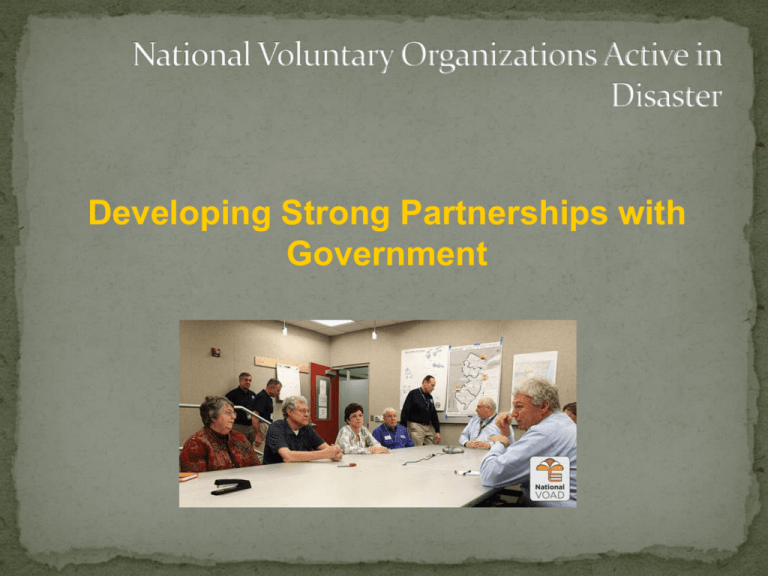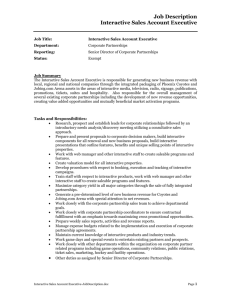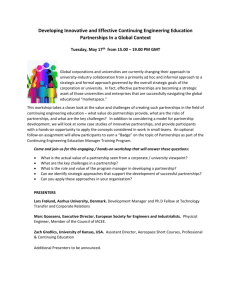National Voluntary Organizations Active in Disaster
advertisement

Developing Strong Partnerships with Government Identify successful practices for forming and doing work through partnerships with government Understand the needs and motivations of potential government partners Understand your own organization and what it can bring to a partnership Learn to target a recruiting message to potential partners a mutually-beneficial working relationship entered into by organizations* in which each partner has needs and brings value. Our most successful with government partnerships were... List the signs that let you know a partnership has been successful: 1. 2. 3. List contributing factors to the success or failure of these partnerships: 1. 2. 3. Let’s look at this last list. Note that some of the characteristics are probably about the relationships we build with partners and some are about the actual work we do together. It takes paying attention to both the work and relationship aspects of partnerships to make a successful partnership. As you start a new partnership or enhance an ongoing one, consider the time spent on fostering relationships compared to planning work tasks. It is critical that attention be paid to the development of skills, knowledge, and training that helps partners balance the relationship building needs with the work of the partnership. Let’s take a moment to frame our discussion about developing successful partnerships that engage volunteers. Often, these partnerships cross sectors and engage us in relationships with partners from all three sectors (business, nonprofit, and government). One thing we’ve learned is that all three sectors need to develop a mutual understanding of one another and their respective agenda, cultures, and operating practices in order to develop effective partnerships. Research indicates that cross-sector partnering is distinctive from other types of partnering because the participants in any such alliance are more likely to have noticeably different styles of: Language or jargon measurement of success performance measures pace decision-making styles competition organizational cultures As you think about what you bring to a partnership in terms of strengths, it is also important to consider what you bring in terms of other characteristics as well. What are some of those characteristics: 1. 2. 3. The Partnership Standards of Excellence is a guideline to help organizations improve their chances of a successful partnership and to help measure the quality of their partnerships. Several years ago, Connect America, a program of the Points of Light Foundation, established a focus group of nonprofit, business, government, and community leaders with experience in multi-sector partnerships and organizational leadership to help develop and validate the Partnership Standards of Excellence. Standards for Processes and Procedures for Creating Partnerships that Work… 1. 2. 3. Manage the partnership’s work with a plan that drives toward outcomes. Foster and manage the partnership’s working relationships as thoroughly as the partnership’s work. Engage volunteers effectively throughout the work of the partnership. Has the partnership developed a vision statement and desired outcomes? Is the focus on the community issues that need to be addressed? Is there a written action plan with desired outcomes, goals strategies, evaluation system, timeline, and budget? Does the partnership evaluate its work as well as the working relationships and the engagement of volunteers? Does the partnership have a charter, such as a Memorandum of Understanding or a letter of agreement that states the purpose of the partnership and identifies roles and responsibilities for the partnering organization, including volunteers? Do the participating organizations view the partnership as a mutually beneficial relationship in which each partner brings value and receives value? Are you fostering positive relationships in the partnership? Are you being flexible, communicating, and accountable? Are volunteers seen as valuable resources? Are they engaged? Are the roles of volunteers in the partnership clearly defined? Are volunteer contributions recognized? Understand your own organization 2. Understand needs and motivation of the other organization 3. Identify common interests 4. Plan together, plan early , and put it in writing 5. Agree on roles, tasks and responsibilities And ...Celebrate! communicate communicate communicate 1. Plan Exercise Train 1. 2. Understanding your own organization What do you need/want? What do you offer? Is your organization ready to partner? Understand needs and motivation of the other organization What do they want? What can they offer? What is your history with them? What opportunities are you bringing? 3. 4. Identify common interests Identify community leaders who can convene others Articulate issue in terms of needs of community and people Articulate vision of clearly understood positive outcomes Consider -- who else should be ‘at the table’ Plan together, plan early, and put it in writing Gather information from partners about desired outcome or expected results Articulate the broadly worded goals or desired results Small group takes the information to draft a work plan Present draft work plan to partnership for feedback Modify draft Present modified version to partnership for acceptance 5. Agree on roles, tasks and responsibilities Clearly define the roles and responsibilities related to the partnership in the partnership agreement. 6. And ...Celebrate! Okay, there is a sixth step. Celebrate the successes of the partnership along the way; don’t wait for it to be over to recognize your accomplishments. What do you have to offer? What experiences, skills, opportunities are government partners looking for? As you consider your answers, do you have in mind a company, nonprofit, government agency, or community of faith that you think matches your needs? Is it a group that you may not have considered before as a partner? Consider your existing partnerships: do your needs and offerings still match? Do you or they have new resources to offer or needs to be addressed? Think up a 1 minute stoop speech! Knowing what you do about your assets and needs as a partner, if you only had 1 minute to interest a potential partner, what would you say? For organizations in existing partnerships, it is critical to understand that successful partnerships manage the relationship and not just the initial deal. If you are in an existing partnership, this might be a good time to stop and conduct a partnership check-up: how well you are doing in the listed areas? Managing the volunteers well Checking your actions against the points of agreement Asking for feedback on how well the organizations work together Documenting the partnership’s successes Communicating the successes with partners, staff, volunteers, the public, and policy makers Even if your needs are immediate and short-term, work so that you build long-term relationships with your partners.





